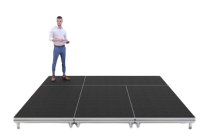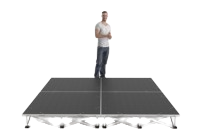Stage Podium
A well-built stage podium sits at the heart of countless public gatherings. Concert halls employ it for recitals, civic centres rely on it for official addresses, while schools value the raised visibility it grants at assemblies. Regardless of the setting, the right design promotes clarity, authority, and safety in equal measure. Selecting an appropriate structure, therefore, becomes a practical and strategic decision, not simply an aesthetic one.
Why a Stage with Podium Matters
Any stage and podium arrangement fulfils three fundamental tasks:
- Projects presenters or performers above floor level, improving sightlines.
- Marks a clear focal point, aiding audience engagement.
- Offers a stable base that withstands repeated use without compromise.
In practice, a podium grants both the dignity expected at formal occasions and the technical backbone required by production crews.
Stage and Podium Key Design Factors
Every venue faces distinct pressures: limited space, anticipated footfall, venue access times, or acoustic demands. As a result, one podium stage platform can differ greatly from the next. Designers usually start by weighing up the following elements:
- Height and footprint: Balance unobstructed sightlines against ceiling clearance and backstage movements.
- Surface specification: Non-slip finishes remain standard; darker tones reduce glare under theatre lighting.
- Structural loading: Maximum distributed weight must accommodate people, lecterns, or musical instruments without flex.
- Edge protection: Low-profile treads and colour-contrasted nosing minimise trip hazards.
- Integration: Routed cable paths or recessed tie-points tidy microphone and monitor wiring.
Addressing those details early ensures the podium complements, rather than restricts, wider production demands.
Materials & Surface Treatments
Timber remains a popular core material thanks to its predictable behaviour under load and warm appearance. Powder-coated steel frameworks add stiffness and extended service life, particularly for installations subject to heavy turnover schedules. Some venues favour composite boards pressed with quartz-based grit, trading natural aesthetics for maximum durability. A lightweight laminate might be specified in touring environments where rapid build and break cycles dominate.
Finish choice contributes more than style. A hexa surface curbs glare for television broadcast and aids grip, whereas a polished varnish may be selected to echo heritage interiors.
Safety and Compliance
British Standard codes and the Supply of Machinery Regulations guide podium fabrication. Load testing is generally performed to at least 1.25 times the nominal capacity. Edge protection, where the drop exceeds a nominal threshold, ordinarily includes demountable rails or kick boards. Fire-retardant coatings become compulsory inside venues governed by stringent local authority licences. Attention to handrail spacing and step geometry reduces the likelihood of slips, particularly during low-light changeovers.
Clear documentation underpins the compliance process: structural calculations, inspection intervals, and incident reporting protocols. Maintaining thorough records reassures insurers, event contractors, and attendees alike.
Configuration Variations
No single template suits every event. Several tried-and-tested formats dominate, each tuned to specific scenarios:
- Freestanding unit: Independent structure, often rectangular, positioned wherever convenient.
- Integrated stage with podium: A continuous platform featuring a dedicated presenter's section set slightly forward or raised again.
- Multi-tier layout: Discrete elevations arranged to host multiple award recipients or panel members.
- Corner podium: Space-saving design that nestles against two walls, popular in compact conference suites.
Modularity proves invaluable when venues accommodate contrasting event types throughout a calendar year. Interlocking deck sections, where specified, enable fast reconfiguration without specialist tooling.
Podium Stage Platform Handling and Installation
Even a modest podium must be planned around fit-through points—doors, corridors, loading bays. Lightweight frames reduce manual handling strain, whereas caster sets serve well when daily relocation forms part of the workflow.
Assembly sequences typically follow a simple order: position base frames, secure locking hardware, drop surface elements in place, and attach rails or steps last. That staged process keeps components stable at each step, cutting snagging time later.
Routine Maintenance
A periodic inspection schedule helps preserve performance over the long term. Essential checks include:
- Fastener tightness across joints and brackets.
- Surface wear, particularly at edge corners subject to heavy foot traffic.
- Integrity of non-slip treatments.
- Evidence of moisture ingress where timber forms the load-bearing panel.
Minor defects caught early rarely demand extensive downtime; a prompt repair or component swap keeps the podium in rotation without revisiting the design stage.
Common Deployment Scenarios
The following situations frequently call for a dedicated stage podium:
- Academic campuses: Graduation ceremonies, debates, guest lectures.
- Performing arts venues: Conductor positions, masterclasses, spoken-word recitals.
- Corporate functions: Keynote addresses, shareholder briefings, award presentations.
- Government engagements: Press statements, civic commemorations, policy launches.
- Festivals: Introductions, sponsor acknowledgements, minor acoustic sets.
Each environment introduces its own nuances: rapid turnaround schedules, broadcast requirements, or strict heritage restrictions, but the underlying goal remains consistent: provide a reliable launchpad for clear communication.
Making the Final Selection
Decision-makers often narrow options through a staged evaluation:
- Assess event type and frequency.
- Measure available space.
- Confirm regulatory obligations.
- Calculate long-term return on investment.
- Cross-check compatibility with existing equipment.
A short trial build, even at half-scale, reveals potential pinch points before financial commitment. Manufacturers frequently facilitate such mock-ups, offering technical notes or CAD data to assist.
Conclusion
A stage with a podium does more than lift performers above the floor. It signals professionalism, safeguards participants, and streamlines production logistics. Careful thought at the specification phase, covering layout, materials, safety, and sustainability pays dividends across the structure’s operational life. When properly chosen and maintained, a podium stands as a trusted asset, ready to serve everything from intimate readings to national broadcasts.








